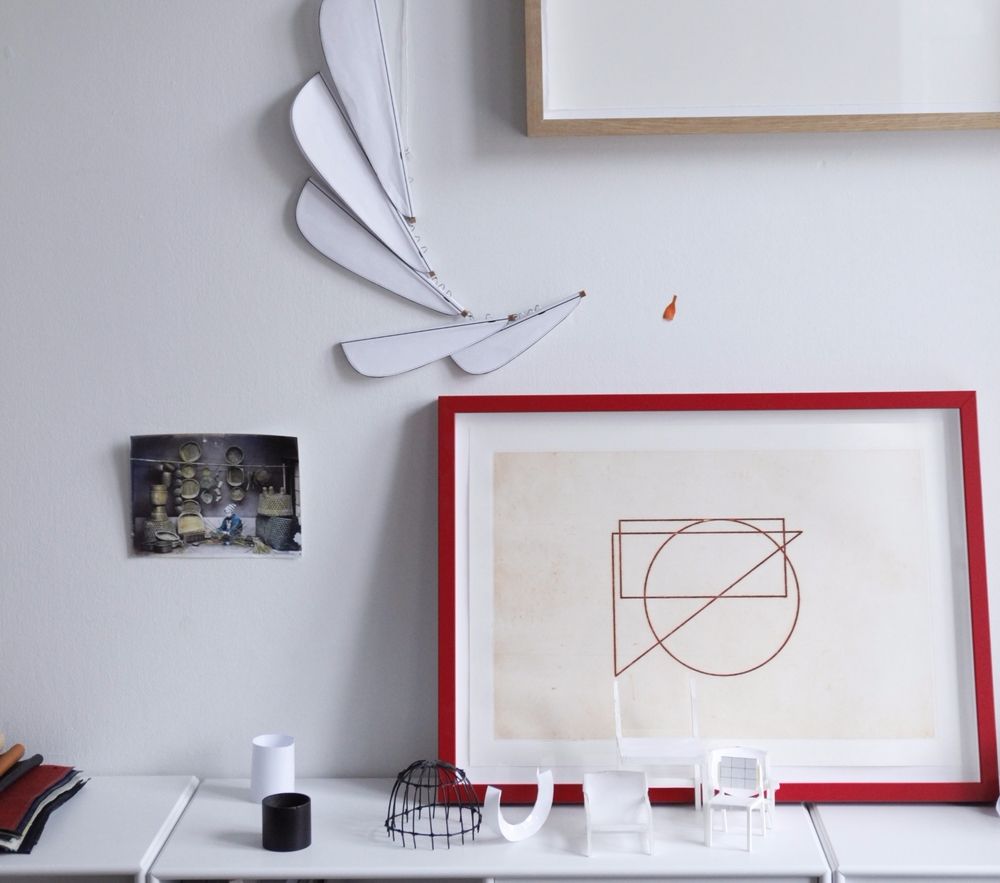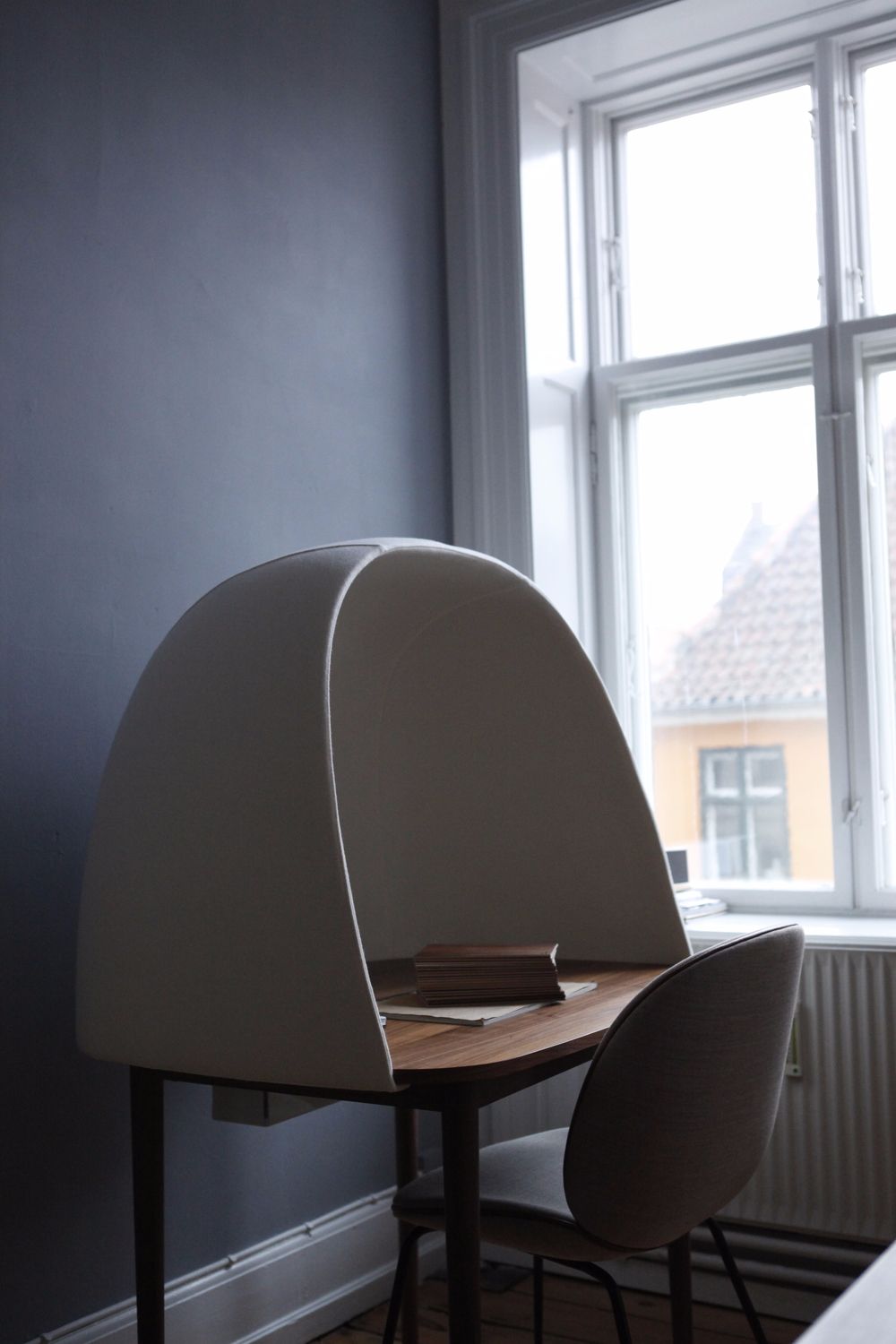Tell me about the day-to-day environment at your studio.
Enrico Fratesi: It’s very intense, and very intimate. We started in 2006 while studying architecture [at the University of Ferrara, in Italy]. We were partners first. The idea was never for us to be working together.
Stine Gam: We’re the same age, we’re both European, but we’re so different in how we do things.
Fratesi: We’re like an energetic bubble. We often speak Italian when we do intense projects. Usually the language is English, because we have people from all over the world in our studio. Often they will think we’re having a big fight in Italian, but actually, we’re just discussing some details.
Your first product to hit the market was the Cartoon chair for Swedese in 2008. You had another big break with the launch of your Rewrite table for Ligne Roset in 2011. How did the latter come about?
Fratesi: We had won a prize, and part of the prize was to have a solo exhibition at the Danish Museum of Art and Design in Copenhagen [in 2009]. It was a great opportunity to just express a little about our approach. We showed this desk there, where Michel Roset, the company’s director, discovered it.
Gam: We did this not as a commercial piece, but to meet a need in society for something gentle, something that can protect you.
What are you launching at Salone del Mobile this April?
Fratesi: We’re doing projects for Thonet, Porro, and Fontana Arte. We’ve also designed a perfume bottle for an exhibition at the Orto Botanico curated by Ferrucio Laviani. And we’re curating an exhibition at Basilica San Simpliciano, called “Minecraft,” that’s organized by the Ministry of Culture of Denmark.
Will you have work for the Milan Expo in May, too?
Fratesi: Yes, we’re doing something very different for the Milan Expo, for Telecom Italia at the Triennial Design Museum. Also, at the expo, we’ll have our Balance mobiles at the Italian pavilion.
What’s the division of labor between the two of you?
Fratesi: I come from the Italian intellectual process, so for me the concept is always really strong. I always start with the basic idea: What do we want to achieve? Why are we doing this? This vision is always clear, but to get to the vision, we need to complement each other.
Gam: I can’t really accept the vision before the details. There’s such a small borderline before it becomes out of balance and vision gets lost and you start to get annoyed about the wrong details.
How do you view the contrasts between your Italian and Danish backgrounds?
Gam: The Danish tradition is so much more about craft, and the Italian tradition is about really big thinkers who write books and have stuff to say.
As the world globalizes, how do you think national design cultures are changing?
Fratesi: Growing up, there weren’t so many product choices for our families. We’re now wondering what to do with our 3-year-old son. He has already traveled many times, and our house is a mixture of Italian and Danish products and things we’ve bought in Japan.
Gam: Generations have changed, too. We talk to people who are just maybe a couple years younger than us. It’s now difficult in their culture to do something wrong. For them, it’s much easier to do something “right”. I think its helpful to do something a little bit wrong.
Why do you think young designers have trouble with this kind of thinking?
Fratesi: Because on one side of their computer monitor they’re working on a project, and on the other, they have three blogs open. They can’t get away from the Internet. We don’t read too many design blogs.
Gam: This is why in much of our furniture there’s this theme of protecting or embracing. It’s not that you need to cut yourself out—of course you want to be a part of society. It’s just to have some short breaks where you can just get bored. I mean, who gets bored anymore? It’s so difficult to get bored now.
Perhaps through boredom you become creative.
Fratesi: Yes, there is the link. The first moment you’re bored, the next your imagination creates a story. You have to do something from nothing. As kids, we were basically playing with nothing but making stories. Now, of course, you have the world in your phone. You can get music, movies, whatever you ant. This is stopping the imagination of our youth. But it’s difficult to say to younger generations, “You can’t do that!”
How do you think blogs like Dezeen and Designboom are affecting design thinking?
Fratesi: Sometimes we say to Marcus [Fairs, the founder and editor-in-chief of Dezeen], ” You’re creating confusion!” The site does a good job of informing people—an architect needs to know about projects, and people need to know about architecture; it’s good to be informed. We follow it. But it’s about doing so in moderation. We don’t look at it every time we’re free.
When I look at your work, I sense emotion and soul behind it. How do you create a product that’s for the market and pragmatic, but still has emotional heft?
Gam: We’re both sort of nostalgic people. We always have this feeling that we were too late to meet these great masters: the Eameses, Sottsass, Wegner. We can study the same chair by them hundreds of times, and it keeps telling us new stories. It’s like knowing the people who made them without knowing them personally. There’s a strong love of tradition in both of us. Even though our pieces are expressing something new, there’s something traditional about them. Like the Rewrite desk: If you take the top off, it’s just a wooden table. I think it’s very important to have roots. To know these roots well and respect them helps you.
Fratesi: You have to be honest, and you know where you’re coming from and who you really are. I’m an Italian living in Denmark. It would be completely strange for me to want to be Danish. First you have to be respectful of where you life, and have an open view of the life and habits there. But you also have to remember your differences and bring them with you in a different way, maybe through work instead of daily life. It’s important to give value to diversity instead of trying to be homogenized. I remember the last day before I moved to Denmark from Sweden, where I was studying at the time, my teacher said, “Don’t try to become Danish!” That was good advice.


